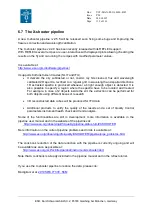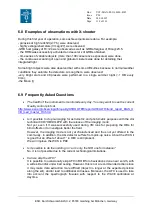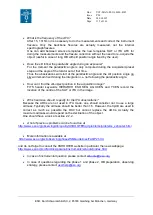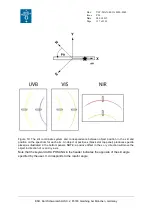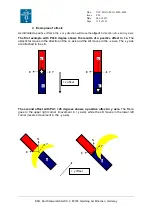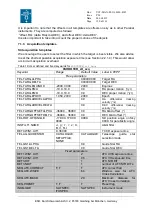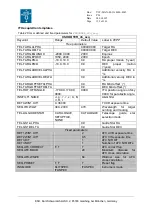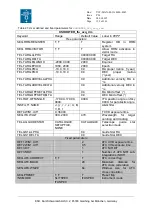
Doc:
Issue
Date
Page
VLT-MAN-ESO-14650-4942
P96
24.06.2015
108 of 161
ESO, Karl-Schwarzschild-Str. 2, 85748 Garching bei München, Germany
6.3 Flat-field and Wavelength calibrations
WARNING: ALL EXPOSURE TIMES WILL BE REVISED TO PROVIDE BETTER
CALIBRATION FRAMES.
Flatfield spectra allow to correct for the pixel-to-pixel variations in detector sensitivity as a
function of impinging wavelength of the light and to correct for the structures introduced by
imperfections of the slits. They also provide a good correction of the blaze function of the
For each arm, a dedicated halogen lamp with appropriate balancing filters is available to give
well-exposed, flat continuum spectra at all wavelengths within a reasonably short exposure
time (see Table 17). A deuterium lamp is used for the spectral region shortwards of 350 nm.
Flatfielding the whole spectral range therefore requires four exposures (2 in UVB, 1 in VIS
and ON/OFF in NIR) that have to be taken sequentially. Flatfield templates are:
XSHOOTER_slt_cal_UVBLowLampFlat
(UVB deuterium-D
2
- lamp flat)
XSHOOTER_slt_cal_UVBHighLampFlat
(UVB halogen lamp flat)
XSHOOTER_slt_cal_VISLampFlat
XSHOOTER_slt_cal_NIRLampFlat
And their equivalent for IFU flatfield named
XSHOOTER_ifu_cal_...LampFlat
.
Note that low frequency fringes with peak-to-valley amplitudes up to ~5% are present in the
red part of the VIS spectra.
Table 17: exposure time for arc frames and flat field frames. Values are given for the fast readout,
low gain mode (in UVB and VIS) for a 1.0" or 0.9" slit and the IFU. For the flatfield, values can be
adapted to other slit widths and readout modes applying a simple scaling. These values depend
on the lamp but should be closed to those indicated in this table.
UVB
1x1, low gain
VIS
1x1 low gain
NIR
ThAr arc lamp
Slit 1.0”
30 s (TBC)
Slit 0.9”
5 s
Slit 0.9”
0.66 s
IFU
45 s (TBC)
IFU
4 s (TBC)
IFU
1.32 s
9-pin.
15 s
9-pin.
10 s
9-pin.
0.66 s
Flatfield
Slit 1.0”
D
2
7.3 s
Slit 0.9”
18.8 s
Slit 0.9”
20 s
Halo
19.3 s
IFU
D
2
14 s
IFU
52 s
IFU
30 s
Halo
32 s




















